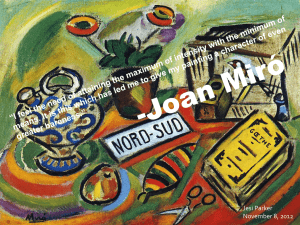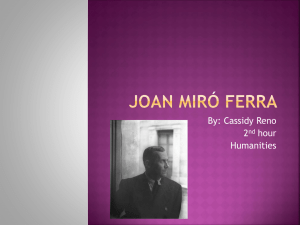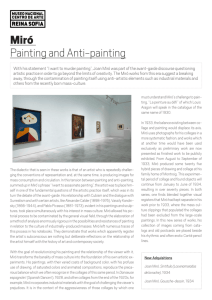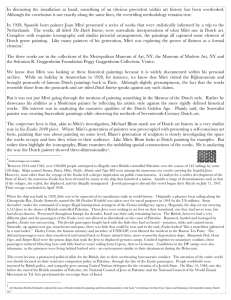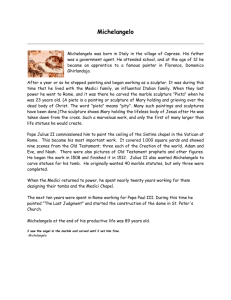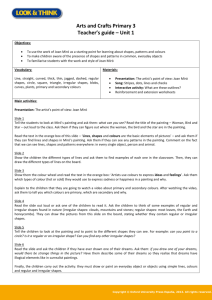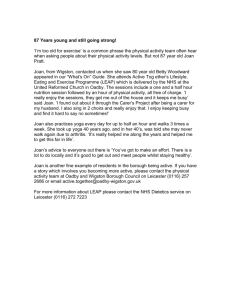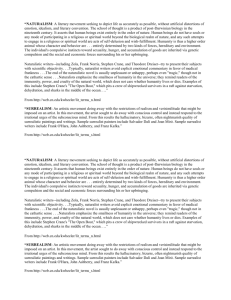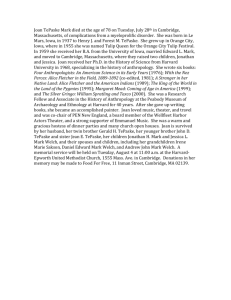Press Kit - Fundació Joan Miró
advertisement
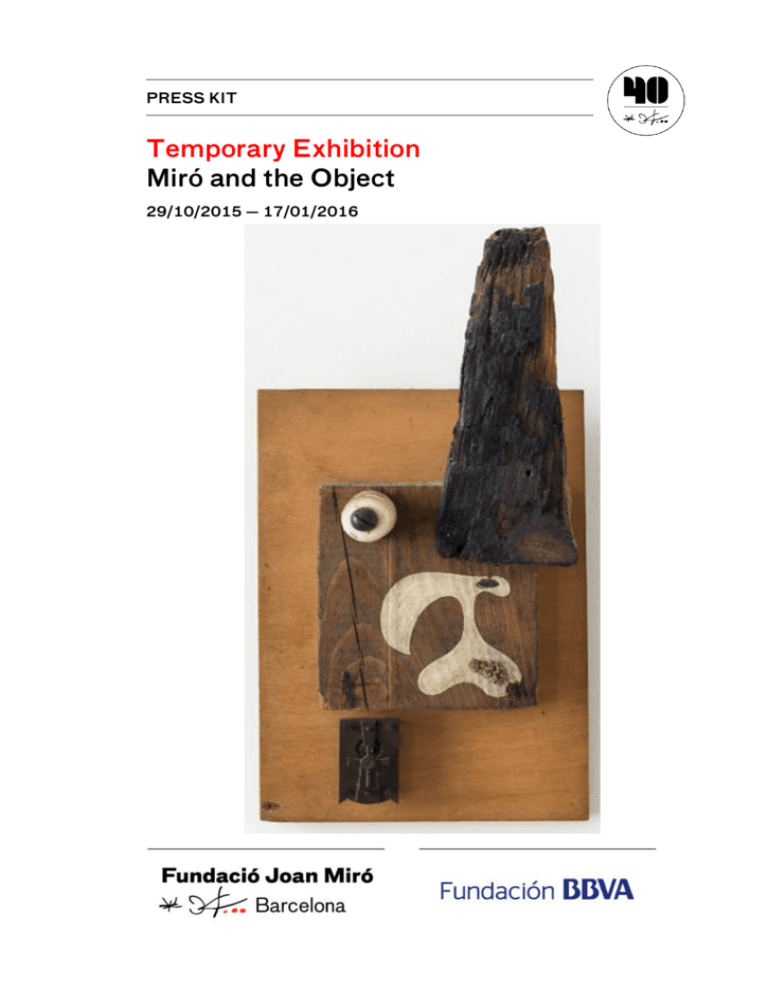
PRESS KIT Temporary Exhibition Miró and the Object 29/10/2015 — 17/01/2016 Contents Introduction Press Release Curator Exhibition and artworks Publication Activities Practical information Contact details 2 3 6 7 31 32 33 35 1 Introduction Miró and the Object 29 October 2015 – 17 January 2016 Opening: 28 October 2015, 7.30 pm Curator: William Jeffett and the Fundació Joan Miró Sponsored by the BBVA Foundation The Fundació Joan Miró presents Miró and the Object, the first exhibition to specifically explore the presence of the object in the work of Joan Miró. Sponsored by the Fundació BBVA and curated by William Jeffett, the exhibition looks at how Miró began with pictorial representation of objects, moved onto physically incorporating them in his works through collage and assemblage, and ended up exploring new techniques such as ceramics and sculpture. Miró and the Object presents over a hundred works including paintings, ceramics, and sculptures from the Fundació Joan Miró collection and important public and private collections in Europe and America, as well as a selection of original objects that the artist collected throughout his life. The overall selection, with a strong visual impact and thorough scientific rigour, includes works that have never been exhibited in Spain, such as Portrait d’une danseuse [Portrait of a dancer, 1928] from the Centre Georges Pompidou in Paris, and Les joujoux [The toys, 1924], from the Moderna Museet in Stockholm. Other highlights include Still life I (The stalk of wheat) and Still life II (The carbide lamp), two paintings from 1922-1823 belonging to the MoMA collection in New York, which have not been exhibited at the Fundació since 1993. Miró and the Object also presents four assemblages of objects from the series Miró produced in 1931, which are shown together for the first time, and two 1929 collages, one of which will join the Fundació’s collection as a permanent loan to mark its 40th anniversary. Miró and the Object will be open to the public until 17 January 2016 at the Fundació Joan Miró, and will travel to CaixaForum Madrid in spring 2016. 2 Press Release Miró and the Object 29 October 2015 – 17 January 2016 Opening: 28 October 2015, 7.30 pm Curator: William Jeffett and the Fundació Joan Miró Sponsored by the BBVA Foundation Barcelona, 27 October 2015. “To make use of things found by divine chance: pieces of iron, stones, etc., just as I make use of a schematic sign drawn on paper by chance, or of an accident that also takes place by chance. That magical spark is the only thing that matters in art.” (Joan Miró. Anotacions de treball (Working Notes), 1941-42, Fundació Joan Miró, Barcelona). The creative process of Joan Miró (Barcelona, 1893) throughout his career can be read through his relationship with objects, from the earliest paintings to the bronze sculptures, by way of the collages and assemblages. Miró and the Object is the first exhibition to monographically explore this relationship, tracing the presence of the object and its evolution through the different stages of Miró’s oeuvre. Sponsored by the BBVA Foundation and organised by the Fundació Juan Miró, Miró and the Object is curated by renowned Miró expert William Jeffett, Chief Curator of Exhibitions at the Dalí Museum in Saint Petersburg (Florida), with the support of the Conservation Department at the Fundació Joan Miró. The exhibition is based on Miró’s enduring fascination with objects, which led him to find and collect elements of the most diverse nature, originally with the intention of decorating his studio and generating a particular creative atmosphere. Like the Dadaists and Surrealists, Miró was open to the unexpected, and his intrinsic poetic sensibility led him to find a source of inspiration in these chance discoveries. This taste for objects soon led Miró to represent them in his paintings, and then incorporate them into collages, ceramics, and sculptures. In a 1936 letter to Pierre Matisse, he wrote: “I feel myself attracted by a magnetic force to an object, and then I feel myself being drawn towards another object which is added to the first, and their combination creates a poetic shock – which makes the poetry truly moving, and without which it would have no effect.” Miró and the Object is structured into six themed areas that explore the artist’s initial evolution from the pictorial representation of the object to its physical incorporation in the painting through techniques such as collage and assemblage, a process that was in many respects a direct challenge to the visual arts in the late 3 twenties. As Jeffett says, “by at least 1927, [Miró] had used the expression ‘I want to assassinate painting’, by which he meant he wanted to destroy a certain idea of painting understood as easel painting on canvas. This led him rapidly to the use of objects and object assemblages put in a poetic relationship that suggested a way of representation beyond painting, an intervention in the real world.” The exhibition shows how, over the following decade, the artist gradually introduced more heterodox and anti-artistic materials into his work, to the point of approaching painting itself as an object, as in the pictorial images generated by collage technique. It was a transformation that reflected his profound crisis in relation to conventional painting, and placed the object at the very centre of a new poetic approach in his work. Miró and the Object illustrates how this tendency culminates after the Spanish Civil War and World War II, with Miró’s foray into ceramics and sculpture, which became an essential line of work towards the end of his career, along with the socalled second “assassination of painting” and “anti-painting”. In this regard, Jeffett says: “Miró first explored the idea of anti-painting in 1930, in a series of paintings in where he carefully calculated a composition and then cancelled it out by crossing out the image. […] In 1974 Miró did a series of burnt paintings for his great retrospective at the Grand Palais in Paris. At the same time, he proposed a series of bronze sculptures, also made out of assemblages of objects, ceramics, and tapestries, as poetic modes beyond painting.” It was new, radical, and challenging work showing to be a dynamic, innovative creator. The artist was 81-year old. Miró and the Object allows visitors to discover the Miró who challenged painting and, precisely through his dialogue with the object, contributed to bringing about a major change in the conception of art. The narrative of the exhibition unfolds through almost 200 pieces, including a selection of different kind of objects that Miró amassed throughout his life as a source of inspiration or raw material for his compositions, and around 120 finished works from the Fundació Joan Miró and important public and private collections in Europe and America, including paintings, collages, assemblages, ceramics, and sculptures covering an extended period from 1916 to 1981. The exhibition is rounded off with two series of photographs by Claude Gaspari and Planas Montañá that document Miró’s working process with objects in the sixties. Visitors will also be able to view two supporting film documents: a 1939 excerpt of Bizet’s Jeux d’enfants, and a documentary about Miró’s burnt paintings by Francesc Català-Roca. Lastly, a video explaining the main theses of the project has been produced for the occasion, with the participation of the curator William 4 Jeffett, Miró’s grandson Joan Punyet Miró, ceramicist Josep Llorens Artigas, and Rosa Maria Malet, Director of the Fundació Joan Miró. The video can be viewed in the third section of the exhibition. The selection, with a strong visual impact and thorough scientific rigour, includes works that have never been exhibited in Spain, notably the collage Portrait of a dancer (1928) from the Centre Georges Pompidou in Paris, and the painting The toys (1924), from the Moderna Museet in Stockholm. Other notable works include Still life I (The stalk of wheat) and Still life II (The carbide lamp), two paintings from 1922-23 belonging to MoMA, which were last exhibited at the Fundació in 1993. The exhibition presents four assembled objects –which are being exhibited together in Barcelona for the first time– from the small, delicate series that Miró produced in 1931. Of the several collages in the show, there are two significant works from 1929, one of which will join the collection along with the collagepainting from 1933, Painting, as new permanent loans on the occasion of the 40th anniversary of the Fundació. Cadre-objet [Painting-Object, 1972] also returns to the Fundació exhibition rooms. And among Miró’s later works, the exhibition features the exceptional Les oiseaux de proie foncent sur nos ombres [The birds of prey swoop down on our shadows, 1970], an oil on cowhide in the last section of the show. The project is complemented by a publication that includes testimonial, interpretative and critical texts by the curator William Jeffett, artist Perejaume, Miró’s grandson Joan Punyet Miró, and Didier Ottinger, Chief Curator at the Centre Georges Pompidou in Paris. To expand the reach of Miró and the Object, the Fundació Joan Miró has designed a programme of activities that includes a contemporary dance performance by Lali Ayguadé in the exhibition rooms, a family programme featuring the objecttheatre show Menut cabaret by Sola & Tully and the workshops The Visible Object by PEF/Petites experiències fotogràfiques and Unexpected Volumes, organized by Experimentem amb l’ART. This year, the annual event that the Fundació dedicates to the publishing world during the Christmas season will also be linked to the exhibition. Miró and the Object will open on 28 October 2015, and will be on display until 17 January 2016 at the Fundació Joan Miró. In spring 2016, the show will travel to CaixaForum Madrid. 5 Curator William Jeffett holds a PhD in Art History and has been Chief Curator of the Dalí Museum (St Petersburg, Florida, United States) since 1998. The sculpture of Joan Miró was the subject of his doctoral thesis, which he presented in 1992 at the Courtauld Institute of Art, London University, under the title Sculpture into Objects; Objects into Sculpture: A study of the Sculpture of Joan Miró in the Context of the Parisian and Catalan Avant-gardes, 1928-1983. In addition to his projects for the Dalí Museum, William Jeffett has curated exhibitions at The Sainsbury Centre for Visual Arts (Norwich, United Kingdom), Institut Français in Spain, IVAM (Valencia, Spain), Albuquerque Museum of Art and History (United States), Bass Museum of Art (Miami, United States), Museo Thyssen-Bornemisza (Madrid, Spain), Consorcio de Museos de Valencia (Spain), the McKinney Avenue Contemporary (Dallas, United States) and the Fundació Pilar i Joan Miró (Palma de Mallorca, Spain). Jeffett works as a critic, writer, and curator and has taught and imparted lectures at numerous academic institutions including the University of South Florida (Tampa, United States), the University of East Anglia (Norwich, United Kingdom), Lacoste School of the Arts (Vaucluse, France), and Yale University (New Haven, Connecticut, United States). 6 Exhibition and artworks 7 1. A World of Objects “I find all my themes in the fields and on the beaches. Pieces of anchors, rudders, starfish, and tiller handles – they all turn up in my compositions […].” (Joan Miró in Joaquim Gomis/Joan Miró. Fotografies 1941-1981: Retrat d’un univers. Barcelona: Gustavo Gili, 1994) Throughout his life, Joan Miró collected a wide range of objects, a selection of which is displayed in the glass cabinet in this first section of the exhibition, which introduces visitors to the particular atmosphere of inspiration that surrounded the artist in his studio. This display case, closely linked to the surrealist cabinets de merveilles, includes a selection of objects that familiarise us with Miró the harvester/collector. Like the Dadaists and Surrealists, Miró was open to surprise and unexpected discoveries. In these finds, he tended to identify with anonymous, primitive, and popular forms of art, as can be seen in this section: pre-Columbain objects, African sculptures, wooden tools, roots, bread figures, pieces of pottery, siurells (Majorcan whistles), nativity scene figurines, children’s drawings, gegants and mythical beasts, puppets, and toys, all of which stimulated and inspired his work. Little by little, Miró built up an imaginary museum of found objects that filled his studios and were reflected in his works. Ordinary domestic objects are given pride of place in Miro’s first still lifes from 1916. These paintings were a prelude to his later fascination with objects and, by extension, to his treatment of paint as an object in itself. In the exhibition catalogue, the artist Perejaume emphasises their tactile quality, a legacy of his time as a student with Francesc d’Assís Galí. As Gaëtan Picon recounted in 1976, Miró described his classes as follows: “He would have me close my eyes and feel an object, or even a fellow-student’s head, with my fingertips, and then I had to draw it from memory, with the memory of my hands.” This first section shows Miró’s early fascination with objects, and his first creative relationship with them based on pictorial representation. It includes a series of still lifes, notably two 1922-23 paintings from MoMA, New York: Still Life I (Wheat Stalk) and Still Life II (Carbide Lamp), as well as the 1916 oil on paper The pot. Miró explicitly mentioned the importance of the first two works as his first conscious attempts to incorporate ordinary objects in his oeuvre, and to defend the value of humble elements as artistic materials. These two paintings have not been exhibited at the Fundació since 1993. 8 Joan Miró The pot, 1916 Oil on paper 48.5 x 59.5 cm Private collection © Successió Miró, 2015 Joan Miró Nature morte II, 1922-1923 Still life II (The carbide lamp) Oil on canvas 38 x 46 cm The Museum of Modern Art, Nova York. Purchase, 1939 © Successió Miró, 2015 Joan Miró Nature morte I, 1922-1923 Still life I (The stalk of wheat) Oil on canvas 38 x 46 cm The Museum of Modern Art, Nova York. Purchase, 1939 © Successió Miró, 2015 9 2. The Assassination of Painting “I have an utter contempt for painting. The only thing that interests me is the spirit itself, and I only use the customary artist’s tools – brushes, canvases, paints – in order to get the best effects. The only reason I abide by the rules of pictorial art is because they’re essential for expressing what I feel, just as grammar is essential for expressing yourself.” (Joan Miró in Francisco Melgar. “Artistas españoles en París: Joan Miró”, Ahora, January 1931, Madrid) When Miró met André Breton, the artist began his involvement with the surrealist movement. With his 1928 series of collages Spanish Dancers and the 1928 Untitled collages made out of non-artistic materials, he had already started to replace the pictorial representation of reality with collage and objectual elements. In 1930 he produced a series of (anti-)paintings in which the images had been erased or crossed out, and a year later he was already immersed in the production of a series of object-paintings, or assemblages of found objects. Pushing this new logic to the limit, Miró ended up proclaiming his intention to “assassinate painting”, as Maurice Raynal reported in his anthology as early as 1927. Miró’s attack on painting and its conventions suggested a new approach to the medium, which ended up transforming the way we collectively understand art. In this period, Miró understood that representational painting no longer corresponded to artistic truth. He then started to approach collage as a more appropriate form of creation in which objects began to represent themselves, given that the materiality of the fragments inherently invokes an objectual universe. However, this technique also turned out to be a manipulation of reality in a sense. In his endless quest, Miró ended up introducing increasingly material elements into his work, to the point of opening the door to actual objects. The first of his paintings treated as objects, which could actually be considered his first sculptures, also came out of this progression. The physical object had emerged in his work, and it was there to stay. In this increasingly objectual universe, certain subjects linked to the surrealist world became a recurring presence. One of these, the world of children, is represented in the exhibition by the painting The toys, on loan from the Moderna Museet in Stockholm, which is exhibited in Spain for the first time. 10 A particularly significant work in this section is one of Miró’s four “Spanish Dancers”, the 1928 collage Portrait of a dancer that is also exhibited here for the first time in Spain, on loan from the Centre Georges Pompidou. This work belonged to André Breton and is now part of the Collection of the Centre Georges Pompidou. The collages in this room also include two notable untitled from 1929: one in pencil and collage on paper –which will become part of the Fundació’s collection as a new permanent loan to mark the Fundació’s 40th anniversary– and another on wove paper, which can be seen here for the first time in Spain, on loan from a private collection. This second work, belonging to the Fundació, is a collage reinterpretation of an earlier painting from 1925, and as such a concrete example of Miró’s assassination of his own painting. Representing the anti-paintings from this period, which Miró rejected by crossing out the images, this section includes two large oils on canvas dating from 1930, one of which is on loan from the Musée Cantini in Marseille and the other from the Musée de Grenoble. Lastly, in this section the Fundació Joan Miró presents, together for the first time, four assembled objects from the series that Miró created in 1931. The set is significant because of the singularity of these works and because they include very fragile elements. It was precisely after seeing these works that the writer Boris Kochno invited Miró to create the set and costumes for Jeaux d’enfants by the Ballet Russe de Montecarlo, which premiered in 1939. To illustrate this episode, this section also contains an excerpt from this ballet filmed the year of its premiere. Joan Miró Les Joujoux, 1924 The toys Oil and charcoal on canvas 73 x 92 cm Moderna Museet, Stockholm Photo: Moderna Museet, Estocolmo © Successió Miró, 2015 11 Joan Miró Untitled, 1924 Pencil, pastel crayon, watercolour and collage on paper 47 x 62 cm Private collection © Successió Miró, 2015 Joan Miró Portrait d'une danseuse, 1928 Portrait of a dancer Cork, feather and pin fixed on wood panel with Ripolin 100 x 80 cm Centre Pompidou, Paris. Musée national d'art moderne / Centre de création industrielle. Gift of Aube Breton-Elléouët, 2003 ©Centre Pompidou, MNAM-CCI, Dist RMNGrand Palais/Philippe Migeat © Successió Miró, 2015 Joan Miró Untitled, 1929 Conté pencil and collage on paper 102 x 68 cm Private collection © Successió Miró, 2015 12 Joan Miró Painting, 1930 Oil on canvas 230 x 165 cm Musée de Grenoble, Grenoble. Gift of Pierre Loeb, 1934 © Musée de Grenoble © Successió Miró, 2015 Joan Miró Object, 1931 Oil, insulator, screw, burnt wood, sand and clockwork elements on wood 27 x 13.5 x 6.8 cm Private collection, Paris © Successió Miró, 2015 Joan Miró Object, 1931 Oil, nails, bone and little bell on wood 30 x 22 x 7.6 cm Frederick R. Weisman Art Foundation, Los Angeles © Successió Miró, 2015 13 Joan Miró Object, 1931 Cake tin, gearwheels, cardboard grille, sand and oil on wood 13.5 x 20.5 x 5 cm Kunsthaus, Zurich. Gift of Erna and Curt Burgauer Collection, 1987 © Successió Miró, 2015 Joan Miró Object, 1931 Oil on wood mounted on wire netting 36 x 26 x 3 cm Centre Pompidou, Paris. Musée national d'art moderne / Centre de création industrielle. Purchase, 1985 © Successió Miró, 2015 Joan Miró Untitled, 1929 Pencil, Indian ink and collage on paper 72 x 104 cm Private collection © Successió Miró, 2015 Joan Miró Painting, 1930 Oil on canvas 150 x 230 cm Centre Pompidou, Paris. Musée national d'art moderne / Centre de création industrielle. Gift of Pierre Loeb, 1949. On loan from Musée Cantini de Marsella, 1986 © Successió Miró, 2015 14 3. From Collage to Sculpture “I only use the objects I find. I gather them altogether in my studio, which is very large. I lay the objects all around on the floor and I choose this one or that one. I never make sculptures from sketches, I just put them together.” (Joan Miró in Dean Swanson. Interview de Miró à propos des sculptures. Minneapolis: Walker Art Center, 1971) Around the thirties, Miró adopted collage as the basis for a model that could transform painting through drawing-collages and collage-paintings, a technique that offered him a new process by which to generate images based on fragments of paper. The result was an enigmatic language reminiscent of the primitive markings of cave painting or of children’s drawings, which was sometimes misinterpreted as abstract although Miró always vehemently rejected this label. Miró explained this process in an interview with James Johnson Sweeney in 1948: “I used to tear newspapers into rough shapes and paste them on cardboards...Day after day I would accumulate such shapes. After the collages were finished they served me as points of departure for paintings. I did not copy the collages. I merely let them suggest shapes to me...” Taking these declarations into account, the curator William Jeffett has set up an interesting dialogue between paintings dating from 1933 and their corresponding preliminary collages. One of the things that makes this connection possible is the fact that the Fundació’s archive holds the preliminary collages of virtually the entire series of these paintings, including the 1933 work Painting, which will become part of the collection as a long-term loan to mark the 40th anniversary of the Fundació. In the forties, Miró increasingly used unusual materials and media that are not traditionally associated with the fine arts: chipboard, metal pieces, fibrocement... all of which can be seen in the selection of works in this section. Miró thus continued to violate conventional approaches to painting by incorporating nonpictorial materials or opting for unusual formats, rejecting the traditional function of art as illusion while at the same time affirming its material condition as object. These investigations eventually led him to the world of ceramics and sculpture. At this point, the exhibition includes a 12-minute documentary that reviews the poetics of the object throughout Joan Miró’s oeuvre, with the participation of Rosa Maria Malet, Director of the Fundació, Joan Punyet Miró, the artist’s grandson, ceramicist Josep Llorens Artigas, and the exhibition’s curator William Jeffett. 15 Joan Miró Untitled. Drawing-Collage, 1933 Pencil and collage on paper 108 x 70 cm Fundació Joan Miró, Barcelona. On loan from a private collection © Successió Miró, 2015 Joan Miró Preliminary collage for Painting, 1933 Collage and graphite pencil on paper 47.2 x 63.2 cm Fundació Joan Miró, Barcelona © Successió Miró, 2015 Joan Miró Painting, 1933 Oil on canvas 97 x 130 cm LaM, Lille musée d’art moderne, d’art contemporain et d’art brut, Villeneuve d’Ascq. Gift of de Geneviève and Jean Masurel © Successió Miró, 2015 16 Joan Miró Preliminary collage for Painting, 1933 Collage and graphite pencil on paper 47.2 x 63.2 cm Fundació Joan Miró, Barcelona © Successió Miró, 2015 Joan Miró Painting, 1933 Oil on canvas 130 x 162 cm Private collection © Successió Miró, 2015 Joan Miró Untitled, 1936 Indian ink on a metal piece 18.8 x 23.5 cm Fundació Joan Miró, Barcelona © Successió Miró, 2015 17 Joan Miró Tête, 1937 Head Oil, collage of towel on celotex 121 x 91 cm Fundació Joan Miró, Barcelona © Successió Miró, 2015 Joan Miró Femmes, oiseaux, étoiles, 1944 Women, birds, stars Oil on fragment of fibrocement 33 x 71 cm Private collection © Successió Miró, 2015 Joan Miró Femme, 1946 Woman Sculpture-Object. Bone, grindstone, iron and oil on potter's clay 51.7 x 23.3 x 19.7 cm Fundació Joan Miró, Barcelona © Successió Miró, 2015 18 Joan Miró Et le groupe de personnages dansant la sardane, 1948 And the group of figures dancing the sardana Oil on chipboard 55 x 69 cm Private collection © Successió Miró, 2015 Joan Miró Painting, 1950 Oil, string and casein on canvas 99 x 76 cm Van Abbemuseum Collection, Eindhoven © Successió Miró, 2015 Joan Miró Painting-Object, 1950 Oil on wood, rag, string and cardboard 30.8 x 26.4 cm Private collection © Successió Miró, 2015 19 Joan Miró Objet barbare, 1952 Barbarian object Construction. Oil, paper, string, sponge and metal on wood (artist’s palette and wedges) 35.5 x 22 x 5.8 cm Fundació Joan Miró, Barcelona © Successió Miró, 2015 Joan Miró Painting, 1949 Oil, rope and wire on canvas 22 x 16 cm Joey Esfandi collection © Successió Miró, 2015 20 4. Ceramics and Early Sculptures “After early attempts at sculpture in Galí’s studio at age sixteen, I returned to sculpture in 1945 and made ceramics with Artigas. I saw it as a way of putting painting to the test. I had previously made sculpture-objects, but with a totally different idea, joining unconnected things.” (Joan Miró in Dora Vallier. “Avec Miró”, Cahiers d’Art, 1960, Paris) In the late forties and early fifties, Miró started to use materials that were more closely linked to sculpture, such as iron, ceramics, and bronze. He sometimes combined all of these materials in a single work, as in the series Sculpture-Object (1950) and Projet pour un monument [Project for a Monument, 1954], displayed in this section, which already hint at Miró’s later emphasis on monumentality. Found objects were again a source of inspiration, as can be seen in the striking presence of pumpkins and in a stone head mounted in ceramics or bronze. The granite Tête [Head, 1946-49) –a found object and, to some extent, a kind of poetic self-portrait– became the model for other bronze and ceramic sculptures such as Tête [Head, 1953] and Large figure (1956). Other common, ordinary objects provided a non-conventional medium on which to paint other significant works from this section, such as The ironing board (1953). Before his sculptures, Miró worked intensely on ceramics. To start with, he used leftover fragments found in the studio of ceramicist Josep Llorens Artigas. Miró and Artigas worked together from 1953 to 1956, in a collaboration that was so intense that Miró almost totally abandoned painting to dedicate himself entirely to this activity. He saw ceramics as a return to the essence, with primitive materials and a technique that was totally new to him. His visit to the Caves of Altamira as he prepared the enormous ceramic mural for UNESCO more generally reinforced his understanding of ceramics and of the object in terms of primitive culture. 21 Joan Miró, Josep Llorens Artigas Object, 1956 Earthenware 79 x 42 x 47 cm Jules Maeght Collection, San Francisco © Successió Miró, 2015 Joan Miró Tête, 1946-49 Head Granite 24 x 30 x 23 cm Pierre and Tana Matisse Foundation Collection © Successió Miró, 2015 Joan Miró Projet pour un monument, 1954 Project for a monument Iron, leather, gouache and grease pencil on cement 39.8 x 18.3 x 17.8 cm Fundació Joan Miró, Barcelona © Successió Miró, 2015 22 Joan Miró, Josep Llorens Artigas Large figure, 1956 Earthenware 107 x 48 x 44 cm Fondation Marguerite et Aimé Maeght, Saint-Paul-de-Vence © Successió Miró, 2015 Joan Miró The ironing board, 1953 Oil on wood 157 x 30 x 3 cm Isabelle Maeght Collection, Paris © Photo Galerie Maeght, París © Successió Miró, 2015 23 5. Bronze Sculpture "Raw bronze, so that all the accidents of the plaster and the tools are visible. Cast very roughly, making the most of the accidents of smelting and chance, juxtaposing sheets, leaving it outdoors. (Note written by Joan Miró in a personal notebook, c.1964, Fundació Joan Miró, Barcelona). From the early sixties onwards, Miró increasingly positioned the object at the centre of his poetic language, particularly through his work in bronze sculpture. Specifically, objects functioned as visual metaphors in this new poetics. This can be considered the period of Miró’s greatest dedication to sculpture. At the same time, his interest in the object led to a radical change in his approach to painting and collage. All of this led Miró to revise the discourse on the assassination of painting, which had been so fundamental in his work in the thirties. Miró’s efforts also diversified into other areas beyond painting, such as interventions in the public sphere, actions, monumental and public sculpture, and so on. Collage remained an important influence during this time, as did the heterogeneous approach to painting, a kind of painting that was increasingly transformed by his interest in the object and in sculpture. Miró’s sculptures can be seen as three-dimensional collages, given that he did not conceive his sculptures –like his paintings– in conventional terms. As he explained in relation to the great retrospective at the Grand Palais in Paris in 1974, he also felt the need to go beyond sculpture in the sense of mere volume. Miró then opted to return to using found objects as the basis for creating assemblages in bronze. The model-objects for Miró’s sculptures were often left behind in the different foundry studios where they were cast. Over the years, the Successió Miró has recovered and systematically identified most of these models and crossreferenced them with the bronze sculptures that they eventually turned into. This important work shows the extent to which Miró’s sculpture was truly a poetics of the object. This exhibition includes various examples that allow visitors to contemplate the original objects along with the finished sculptures. As well as the bronze sculptures –some of which Miró painted in order to emphasise the objects– this section ends with two series of photographs by Claude Gaspari and Planas Montañá –some with notes by Miró himself– documenting the artist’s working process and the universe of original objects that became bronze sculptures. 24 Claude Gaspari Assembled objects of the sculpture by Joan Miró Woman and Bird, 1967 No date Copy photo 24 x 13.4 cm Fundació Joan Miró, Barcelona © Claude Gaspari Joan Miró Femme et oiseau, 1967 Woman and bird Painted bronze 120 x 48.2 x 45 cm Fundació Joan Miró, Barcelona © Successió Miró, 2015 Joan Miró L'Horloge du vent, 1967 The wind clock Bronze 50.5 x 30.2 x 16.3 cm Fundació Joan Miró, Barcelona © Successió Miró, 2015 25 Claude Gaspari Model of the sculpture by Joan Miró Her majesty, 1967 No date Copy photo 23 x 18 cm Fundació Joan Miró, Barcelona © Claude Gaspari Joan Miró Sa majesté, 1967 Her majesty Painted bronze 108 x 35.5 x 34 cm Fundació Joan Miró, Barcelona © Successió Miró, 2015 Joan Miró Femme, 1970 Woman Bronze 91 x 39.7 x 25.3 cm Fundació Joan Miró, Barcelona © Successió Miró, 2015 26 6. Anti-painting and the Grand Palais, 1974 "I painted this way after having become obsessed with ‘assassinating painting’. I wanted to eliminate at the root an entire decrepit art, the old conception of painting, so that another art, more pure and authentic, would be born.” (Joan Miró in Lluís Permanyer. “Revelaciones de Joan Miró sobre su obra”. Gaceta ilustrada, 23 April 1978, Madrid-Barcelona) In the late sixties and early seventies, Miró continued to question painting as a valid language for representing reality, and to advance on his investigation into the objectual nature of painting. Now he attacked his canvases by cutting and stabbing to reveal the underlying support, and inviting the observer to look through –and beyond– the surface of the painting. These lacerated, burnt, and otherwise manipulated paintings are displayed alongside painting-objects that function along the same lines as what Miró called “anti-paintings”. In other works, Miró hammered nails into the painting and worked with unusual media such as cardboard, in order to call into question traditional painting as a generator of images and to assert the materiality of the medium. To produce these works, he deliberately chose ephemeral, humble materials. In Miró and the Object this line of work is represented by a pompier-style oil on canvas and another on sandpaper, both dating from 1973, a cowhide painted in oils from 1970, and the 1973 tarpaulin Women, birds, among other works. Miró also damaged his works to try to undermine the economic value of painting on the art market, while at the same time extolling its poetic function, as can be seen in the two burnt canvas from 1973 on display. This section pays particular attention to the major Miró retrospective held at the Grand Palais in Paris, in 1974. Contrary to expectations, Miró insisted that the exhibition in Paris should not be a conventional retrospective. Although it included a section with an extensive overview of his earlier work, the artist added a bulk of new works expressly created for the exhibition. In this way, at the age of 81, Miró presented himself as a dynamic artist, fully involved in the creative process, provocative and innovative. For all of these reasons, the exhibition brought the artist’s most radical work into the foreground: bronzes, ceramics, tapestries, antipaintings... Media that defied the traditional role of pictorial art. The extensive, diverse range of heterodox practices presented in the Grand Palais retrospective also influenced Miró’s poetic exploration in the years that followed. 27 Miró and the Object presents twenty pieces exhibited in that 1974 exhibition at the Grand Palais, most of them from the collection of the Fundació Joan Miró, an international authority on Miró's late work. An example is the 1972 PaintingObject, which returns to the exhibition rooms of the Fundació. Joan Miró Cadre-objet, 1972 Object-Picture Wooden frame, lead, string and metal nut 53.3 x 62.4 x 5 cm Fundació Joan Miró, Barcelona © Successió Miró, 2015 Joan Miró Painting, 1973 Oil on canvas 50 x 61 cm Private collection © Successió Miró, 2015 Joan Miró Femmes, oiseaux, 1973 Women, birds Acrylic, oil and wax crayon on tarpaulin 302 x 257 cm Fundació Joan Miró, Barcelona. Gift of Pilar Juncosa de Miró © Successió Miró, 2015 28 Joan Miró Burnt canvas 1, 1973 Acrylic on canvas, subsequently ripped and burnt 130 x 195 cm Fundació Joan Miró, Barcelona © Successió Miró, 2015 Joan Miró Personnages et oiseaux dans un paysage, 1976 Figures and birds in a landscape Oil on canvas 91 x 166.5 cm Private collection © Successió Miró, 2015 Joan Miró Sobreteixim-Sack 13, 1973 Acrylic, string, felt, wool and metal can on sackcloth 180 x 50 x 13 cm Fundació Joan Miró, Barcelona © Successió Miró, 2015 29 Joan Miró Personnage, oiseaux, 1976 Figure, birds Oil on sandpaper, wood and nails 171.5 x 125.5 cm Fundació Pilar i Joan Miró, Palma Mallorca © Successió Miró, 2015 Joan Miró Les oiseaux de proie foncent sur nos ombres, 1970 The birds of prey swoop down on our shadows Oil on cowhide 250 x 200 cm Isabelle Maeght Collection, Paris © Photo Galerie Maeght, París © Successió Miró, 2015 Joan Miró Oiseau, 1974 Bird Acrylic on canvas, nail, string and gloves 260 x 185 cm Fundació Joan Miró, Barcelona © Successió Miró, 2015 30 Publication The catalogue that accompanies the exhibition explores key aspects of Joan Miró's work in relation to the object. It includes contributions by the exhibition’s curator William Jeffett, artist Perejaume, Miró’s grandson Joan Punyet Miró and Didier Ottinger, Chief Curator at the Centre Georges Pompidou in Paris. More specifically, Jeffett’s text expands on the six sections of the show as a way of exploring and contextualising the dialogue between Miró and the object, Didier Ottinger contributes an essay on the relationship between Miró’s object and Surrealism, and the artist Perejaume presents a text that links Miró’s objectual poetics to his connection to the earth and natural elements. Lastly, Joan Punyet Miró traces a folder containing sketches by the artist of his last sculptures for the Parellada foundry in Lliçà de Munt, which Miró worked closely with to create the bronzes of his late period. Preparing the catalogue entailed extensive documentation work, complementing the texts and the selection of works with reproductions of Miró’s work, as well as photographs from the Joaquim Gomis, Francesc Català-Roca, and Ernst Scheidegger archives that illustrate Miró’s fascination with objects and his working process in relation to them. The Fundació Joan Miró has published three editions of the 216 page catalogue, in Catalan, Spanish and English. 31 Activities In order to expand the reach of Miró and the Object, the Fundació Joan Miró has prepared a programme of activities that includes a contemporary dance performance by Lali Ayguadé in the exhibitions rooms on 24 November. On the occasion of the publication of the book The eye of Miró, a photographic approach to the artist‘s world of objects, the Fundació Joan Miró will offer a dialogue between its authors, Joan Punyet Miró, grandson of the artist, and the photographer Jean Marie del Moral. Education Programme During Miró and the Object, the Fundació Joan Miró’s programme of activities for families and schools will be linked to the project through the following activities: Blueprintings. Objects and landscapes, by CLICme. A photography workshop that recovers the technique of the blueprinting, a photographic in which images on a distinctive blue background are obtained without a camera. The Invisible Object, by CLICme. Photography workshop around the technique of the blueprinting. For families, ages 4 and over. Unexpected Volumes, by Experimentem amb l’ART. A visual arts workshop for families related to the exhibition Miró and the Object, for primary schools and families with children aged 4 and up. Weekends during November and December. Menut cabaret, Sola & Tully. Object theatre. For children 4 and over. A fun and poetic show without words, performed by hands and objects. The life of Menut, a hand that gets bored of playing and decides to become an artist. Books, objects and other meals. 19 December 2015. The Fundació Joan Miró and other groups working in the field of art, design and education have cocreated a book-object based on an unfinished project of the artist. The proposals of this publication serve as a starting point for an afternoon of activities in which families also can create original objects with food. Organized by The Cuscusian*s and Nyam Nyam. The exhibition Miró and the object also has a specific audio guide supervised by the Fundació Joan Miró’s Education Department. 32 General Information Opening Hours Tuesday to Saturday from 10 am to 7 pm Thursdays from 10 am to 9 pm Sundays and public holidays from 10 am to 2.30 pm Closed on Mondays (except public holidays) Admission to the Fundació until 30 minutes before closing Admission charges General admission Adults: 11 € Concessions: students aged 15 to 30, persons over 65:7 € Under 15s and the unemployed (proof required): free admission Admission to temporary exhibitions Adults 7 € Concessions: students aged 15 to 30, persons over 65: 5 € Under 15s and the unemployed (proof required): free admission Annual Pass: 12 € Audioguide: 5 € Articket BCN Visit 6 major art centres in Barcelona for 30 € www.articketbcn.org Accessibility Transport Buses 55 and 150 (Parc Montjuïc bus) Funicular de Montjuïc (metro Paral·lel, integrated fare) We recommend the use of public transport for your visit to the Fundació. Press images and digital press kit available in our virtual press office www.fmirobcn.org/press Follow the activities around Miró and the Object on social media with the hashtag #MiróObjecte and find out more on the website www.fmirobcn.org 33 34
